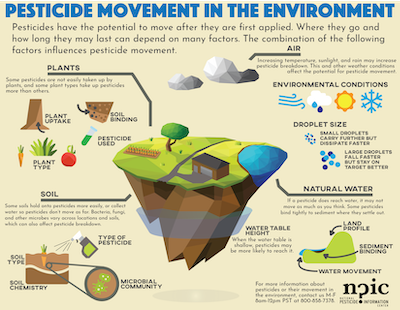A guide to using NPIC's Herbicide Properties Tool
1.800.858.7378npic@oregonstate.edu
We're open from 8:00AM to 12:00PM Pacific Time, Mon-Fri
A to Z
A guide to using NPIC's Herbicide Properties Tool
What is the Herbicide Properties Tool (HPT)?
Users of of the Herbicide Properties Tool (HPT) can compare herbicide active ingredients by water solubility, half-life, sorption potential, and other factors. These properties can help to predict an herbicide's movement through soil, water, and air. This movement is also known as environmental fate.
Who can use the HPT?
The HPT was created for pesticide users or other decision-makers who may need to compare herbicide active ingredients based on how they move or break down in the environment.
How do I use the HPT?
Search for an active ingredient by scrolling through the list of active ingredients or using the search box above the list. Clicking the active ingredient name will open a pop-up box with the ingredient’s chemical properties.
The following table describes the chemical properties displayed in the HPT. These properties may be helpful when estimating pesticide movement in the environment.
Active Ingredient Property (Click the links in this column for additional explanation about the property.) |
Click on the active ingredient name to see the CAS (Chemical Abstract Service) number and all property values available in this tool. |
Water Solubility (mg/L) |
Water solubility is how much of a chemical dissolves into water. This can determine how much will move with water through the environment.
|
| (mmHg at 25°C) | Vapor pressure is how much of a chemical "evaporates" or turns into a vapor and gets in the air. |
Hydrolysis half-life (days) |
Hydrolysis half-life is how quickly a chemical breaks down in water. |
Koc for clay, silty/loam, sandy, or unknown soil types |
Koc is a value to represent how well a pesticide will bind (or sorb) to soil particles.
|
Half-life for clay, silty/loam, sandy, or unknown soil types |
Half-life is how quickly a chemical breaks down in different soil types. |
Groundwater Ubiquity Score (GUS) for clay, silty/loam, sandy, or unknown soil types | The Groundwater Ubiquity Score (GUS) is how likely a chemical is to move through soil toward groundwater. The GUS considers many factors such as soil type and solubility.
|
What else should I consider when thinking about how a pesticide moves in the environment?
- Environmental conditions
- Soil type
- Inert or “Other” Ingredients in pesticide products
Keep these tips in mind when using pesticide products:
- Be sure to read, understand, and follow all of the label directions when mixing and applying herbicides.
- Make sure the label clearly states that the product can be used in the manner you intend to use it.
- Check the "Environmental Hazards" section on the label.
- Use the appropriate amount of pesticide for your job.
- Pesticides applied to sandy or course-grained soils are more likely to leach through the soil and contaminate groundwater.
- Adopting IPM methods for controlling pests can reduce the need for herbicide applications to soils.
For help interpreting HPT values or have questions about any pesticide-related topic, please call NPIC at 800-858-7378 (8:00am - 12:00pm PST), or email at npic@ace.orst.edu.

